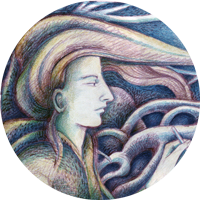At the weekend I did a grass baskets workshop with Ruby Taylor of Native Hands. I have wanted to connect to nature by making something and using my hands. The closest I’ve got so far is making a moss journal. The workshop took place at Wowo campsite in a special campfire area in the woods. First we cut handfulls of grass in an adjacent field, golden and maroon sheeves we carried to the workshop site. After tea, Ruby took us through a few minutes of opening up the senses to the natural world around us. She lit a fire with metal and flint, to have a constant supply of tea throughout the day.




As Ruby pointed out, baskets can be like nests and she brought out a box containing a beautiful nest with a couple of thrush eggshells within it. Birds are the ultimate artisans.
When I was younger, I used to collect nests, empty ones. I climbed trees like many children, fascinated by being up high in the leaves with a birds-eye view. I came across the occasional nest and if it was empty, I’d bring it down if I could. I grew a stash of nests in my bedroom. Unfortunately birds nests harbour fleas so my collection didn’t last for very long.
Thinking about this, I am reminded of some passages in Jay Griffith’s book, Kith: The Riddle of the Childscape about children and nests:
Stumbling on a bird’s nest as a child, I was breathtaken. I gasped at the tenderness of it, the downy feathers, softer than my fingers, moss folded into grasses and twigs in rounds. My eyes circled and circled it, caught by the mesmerizing perfection of the nest. It was the shape of my dream, to be tucked inside a nest and to know it for home.
A nest is a circle of infinite intimacy, a field-hearth or hedge-hearth. Every nest whispers ‘home’, whether you speak English, Spanish, Wren or Robin. Part of a child’s world-nesting need is answered seeing a rabbit warren, a badger sett or otter holt, as children’s writers instinctively know, giving children a secret passage to dens, nests and burrows.
Through nests, a child’s own hearthness is deepened and the child grows outwardly and inwardly into its world. Outwardly, children stare at a nest, fascinated. Inwardly, the nest reflects not just the body’s home but the mind’s. In the snug refuge of the nest, the psyche fills itself out from within, as round and endless as a nest, creating its infinite-thoughted worlds. Intertwined with the world of fur and feather is the world of metaphor where mind makes its nests. Metaphor weaves ‘grass’ and ‘shelter’ together. It ties ‘twig’ to ‘refuge.’ It knits ‘moss’ to ‘home.’
Finding a nest is a homecoming for a child. In Greek, homecoming is nostos, the root of the word ‘nostalgia’—an ache for home, a longing for belonging. Children, filthy little Romantics that they are, have an uncanny gift for nostalgia in nature; something inchoate, yes, but yearning, yearning for their deepest dwelling.
She also has some interesting essays about home as part of the Stay Where You Are project. I never outgrew my fascination with nests, eggs, found animal skulls. I still collect such things when I find them.
Throughout our time in the woods, we heard a persistant blackcap – or at least I think it was a blackcap, blackcaps can sound very similar to garden warblers. A few years ago I spent a few days watching and recording a blackcap singing in a nearby wood as a volunteer for The Woodland Trust, so I am quite familiar with its song. Blackcaps have a lovely, flutey, scratchy song. Here is my recording:
